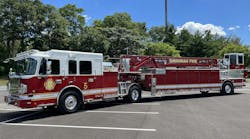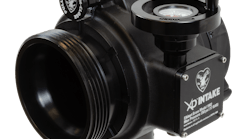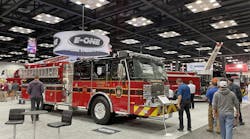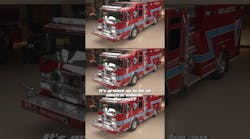In recent years, the U.S. line-of-duty-death rate has dropped below 100 firefighters per year and has stayed there. This is very good news. However, the second-leading cause of firefighter deaths after heart attacks and stress are firefighters dying in motor vehicle accidents responding to and returning from alarms. Many of those firefighters were not wearing seatbelts. No one can dispute the fact that seatbelts that are worn by drivers and passengers during accidents save lives in all vehicles, including fire apparatus and ambulances.
In Wyoming last summer, a U.S. Forest Service Type 3 engine was involved in a rollover accident (see photo). The engine was a Navistar IH 7400 4X4 with a four-door cab. The three-person crew was responding to a wildland call. Just a few miles from their firehouse the apparatus went off the road and rolled over at least five times, according to witnesses. All of the crew were seated and belted. They managed to escape through the driver’s-side door. All suffered some injuries, but they all survived and are doing OK. The apparatus was destroyed. Had they not been belted in, the firefighters probably would have been thrown from the vehicle and badly hurt, if not killed. Another seatbelt success story.
Alarms disconnected
However, as has recently been reported and from my own firsthand knowledge, firefighters are now disconnecting seatbelt alarm systems. This is both an alarming and disturbing trend. A friend of mine runs a big-city fire department shop in the South. He had to fix the same fire truck’s seatbelt alarm systems wiring three times. Firefighters had cut the seatbelt sensor’s wiring.
More recently in California, firefighters were in an engine that crashed into a tree and were not wearing seatbelts. They included a fire captain who crashed through a window. When investigators got a closer look at the engine, they also found the seatbelt sensors and buzzer, which alerts firefighters when someone is not buckled in, had been disconnected and covered over with duct tape. Only minor injuries were reported in that crash. The firefighters were responding lights and sirens when they hit the tree so hard it cleared the top 15 feet off of the tree and caused nearly $250,000.00 in damage to the truck.
Within a month, the department found eight more fire trucks with disconnected sensors and covered alarms to muffle the sound. Investigators found that several of the firefighters on board the apparatus were not wearing seatbelts and that the driver was found to have made an unsafe turn while traveling at an unsafe speed. Memos were sent out ordering firefighters not to alter the vehicles and maintenance crews have shrink-wrapped the wiring to prevent them from being tampered with.
In September, two Tulsa OK, engine companies collided while responding to a call. Four of the eight firefighters and officers on board the trucks were not wearing seatbelts. A captain and engineer involved in the crash have been demoted by the chief and three others involved have had discipline letters added to their files.
Accident investigators soon found that not only were the seatbelt alarms disabled, but one of the on-board cameras was pointed to the ground. This was a big news story in Tulsa and caused the investigation to center on the entire Tulsa Fire Department fleet. It was reported in a wider investigation that most of the fleet had the seatbelt sensors systems disabled and that a majority of firefighters were not wearing seatbelts.
The fire chief sent a stern memo stating that tampering with the fire apparatus safety equipment will not be tolerated and that further action will be taken against those who try and a seatbelt reminder is sent with each dispatch. I have never met the chief of the Tulsa Fire Department, but I like him; a no-nonsense kind of guy who takes the safety of fire department members very seriously and takes decisive action when necessary.
A question always lingers after events like these: What situation in the fire service could exist that would cause a firefighter to be fired? A point to ponder!






